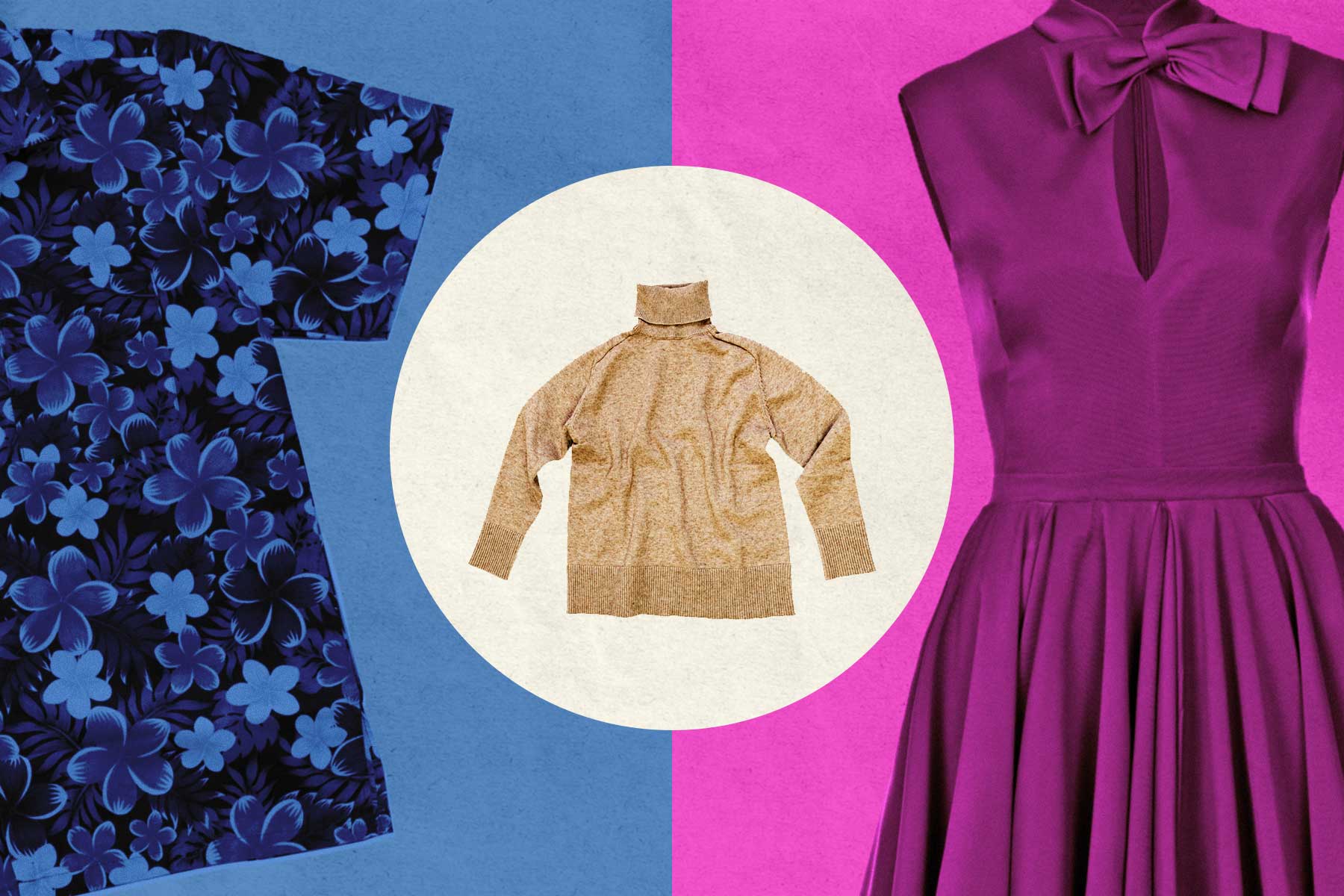You know that sweatshirt you wear when you want to pop across the street to the drugstore and not have to put on a bra? The thing you throw on over nothing else because it reduces you to a shapeless blob, an impenetrable mass devoid of emotion, shape, or gender? That’s the dysphoria hoodie, something that hides your body and gender expression from wandering—and potentially misunderstanding—eyes.
It’s an item born more for function than fashion, one that lacks any room for personal style or expression. Yet it’s been adopted en masse by mainstream brands looking to appeal to gender-ambiguous shoppers. Look at the “gender-neutral” lines of mainstream mall brands like Old Navy, Roots, and H&M and you’ll find a lot of dysphoria hoodies—items meant to affirm but seemingly designed to avoid any sense of silhouette, pattern, or colour. Based off the offerings of most mainstream apparel brands, you’d think “gender-free” was synonymous with no fun—ironic considering many of us who identify outside the gender binary often present ourselves in fruity and extra ways. Last year, a set of button-ups from Old Navy were shared on Twitter (now X) among transmasculine folks, and one of the shirts had a vibrant orange print—and I do mean orange as in the fruit.
For the bottom line of these brands, launching so-called “gender-neutral” lines of hoodies and sweatpants makes sense. A 2022 Unidays survey found that 65 percent of Gen Z respondents believe brands should provide gender-neutral clothing. Non-binary and trans folks are another market to target, as are cis people looking for fits or styles outside of traditionally “gendered” silhouettes, and mass-producing shapeless fabric blobs is easy enough. But it also means pretty much every other clothing item—jeans, dresses, shirts, pants, and more—remains in the clutches of the gender binary.
As a non-binary person, I find it unfortunate to see the only clothes marketed to me come from the haute couture dysphoria hoodie line. Maybe I, an ostensibly gender-neutral person, want to wear hard pants or shirts or dresses or literally anything besides androgynous, shapeless hoodies. Just because something isn’t explicitly for “men” or “women” doesn’t mean it has to be boring as sin. I’m definitely in the “dismantle the gender binary” camp, and a good place to start would be imagining more clothing sections than what we’ve got now: “men,” “women,” and “hoodies.”
It wasn’t always like this. Our modern conception of gender and clothing is a relatively recent development in the grand scheme of history.
For much of human existence, clothes were largely made to keep people warm and covered up. As style evolved in the late Middle Ages, it actually became in vogue for men in Europe to wear tights to accentuate the legs. Pants became masculine attire only in the sixteenth century; previously, both men and women wore what modern people would call skirts and dresses. Over time, clothing started to be used primarily to distinguish between men and women rather than to express social position.
But the modern fashion industry has periodically leaned toward androgyny. In the 1960s, models like Twiggy pioneered a hyper-thin, teenage-bodied, short-haired version of feminine androgyny. The “unisex” movement of 1968 saw runway designers imagine a genderless world of sleek silhouettes. In recent years, celebrities like Billy Porter and Harry Styles have donned dresses on magazine covers and red carpets.
But what Styles wears on the cover of Vogue is very different from what’s typically marketed as unisex clothing. According to the 2021 census, one in 300 people in Canada aged fifteen and older identified themselves as transgender or non-binary. Two-thirds of those respondents were under the age of thirty-five—which could indicate that age group is increasingly embracing fluid definitions of gender. And that doesn’t include the folks who identify as cis and are looking for gender-diverse fashion—I’ve commiserated with many cis butch lesbians about the lack of accessible “men’s” pants for our body types. The need to move beyond today’s potato-sack-esque offerings is clear.
Marie-Eve Faust, a professor at the Université du Québec à Montréal who specializes in fashion management, sizing, and sustainability, says there’s an ease to mass-producing for the familiar “male” or “female” silhouette with little variation. Since many clothing brands are resistant to trying anything that could impact their bottom lines, they’re more likely to stick to what they know.
“If you’re doing garments for women, and you know that this is for one specific target market, it’s easier because your target is well defined,” Faust says. “Whereas if everyone moves towards having gender-neutral [clothes], you’re not having your specific target market to yourself.”
Even companies that are trying to move away from the binary haven’t been able to include everyone. Brands like Both& or Wildfang, which market masculine styles of clothing to folks who don’t have traditionally cis male bodies, are attempting to fill the gap of catering “male” clothing to a so-called “female silhouette” by selling button-up shirts that don’t ride up over wider hips, or pants with wider waist measurements proportional to shorter inseams.
But what does it mean to have an “AFAB” (assigned female at birth) body, as Both& suggests is its target audience? Is it me: five feet six, 210 pounds, a thirty-six-inch waist, and a surgically flattened chest, plus nearly two years on gender-affirming hormone therapy? Is it my five-foot-nine cisgender girlfriend? Or is it a non-binary pal who’s five feet tall and wears a 4X in “women’s” pants? Ostensibly, we are all “AFAB,” but that does little to help categorize us or guarantee that the brand’s clothing will fit any of us.
It’s a problem I encounter in my endless search for pants. At five feet six, I land on the lower end of “men’s” pant inseams. But my wider hips mean I hit the upper end of waist sizes. Finding affordable options that fit me both ways is essentially impossible, so I often pay extra to get my jeans hemmed.
And notably, there’s an even greater lack of inclusive fashion catered to transfeminine folks or cis men looking for feminine clothes. My struggle to find short king pants is hard, but it might be even harder for someone with broad shoulders to find a bra that fits. And while transmasculine folks can dip into boys sizing for our shoes, drag queens can attest to the challenge in finding a size fourteen high heel. This discrepancy can likely be chalked up to misogyny: shifting toward the masculine end of the spectrum is acceptable, but God forbid someone’s masculinity should be threatened by a desire to be more feminine.
These struggles are at the heart of a concerted push to show brands that there is a market outside of those “traditional”—and often hyper-thin—silhouettes in mainstream fashion. Queer and trans folks looking for accessible and size-inclusive clothing outside of the gender binary could be an untapped market and money-making potential for mainstream brands. But outside of the financial benefits, giving people what they actually want and need should be motivation enough.
In 2021, Samuel Braemer co-founded Transforming Style, a personal styling and shopping service targeted at LGBTQ2+ folks, as a way to help them navigate the economic and emotional barriers of the fashion world. They help clients through virtual consultations and in-person shopping, regardless of their gender.
The team recently worked with a thirteen-year-old trans girl in Calgary to help craft a wardrobe for her first time at public school after being home-schooled her whole life.
“We worked with her and her parents to provide her with a wardrobe representative of herself,” he said. “A couple of weeks later, her mum sent us an email with photos of her and said that it was life changing and now she sees herself reflected in the mirror.”
Braemer says personal shopping can be helpful as a support for folks looking to brave in-person shopping.
“It can be very overwhelming to go into a big-box store, a boutique, you know, a mall to shop for your true self,” he says. “The categorization can be overwhelming when it’s categorized by gender.”
An easy answer to the problem of categorization is to mass-produce dysphoria hoodies. But a better solution is doing away with categories altogether by designing clothes that fit a variety of bodies rather than imposing a third “gender-neutral” categorization on consumers.
Lydia Okello, a non-binary model, writer, and content creator who focuses on fat-centred fashion and queerness, says they hope for a world where you can walk into a mainstream retail store and see clothing sorted by style and sizing instead of gender.
“I don’t think that it helps anyone shop better,” they say. “I think it’s just prescribing gender to a piece of clothing that is inanimate and has no gender prescribed.”
They believe that de-gendering fashion will not only provide more space for trans and non-binary folks but also encourage people who haven’t experimented with fashion or expression to do so. Maybe a big cis guy looking for something cozy to wear at home would buy a caftan if it came in his size and wasn’t segregated in the “women’s” section. Maybe more cis women would feel free to experiment outside of traditionally feminine styles if more masculine clothes were accessible to them.
“My dream is a landscape in which people don’t feel afraid to venture out of their usual visual selection,” Okello says. “I think that would be a really exciting world to live in.”





